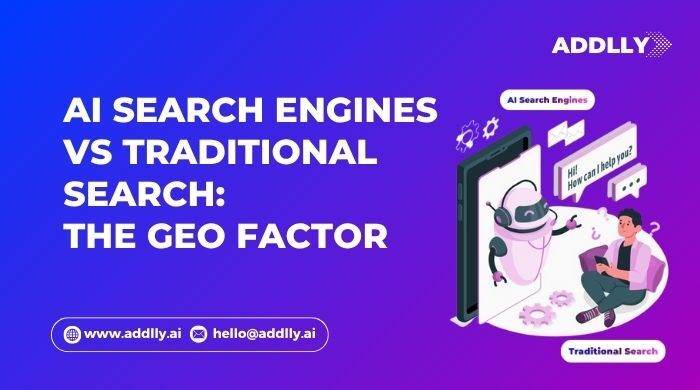Search engines are the backbone of the internet. For over two decades, they’ve been the primary way people find information, explore websites, and make decisions. Traditional search engines, led by Google, have shaped how businesses approach content creation through search engine optimization (SEO).
But in the last few years, a new player has emerged: AI-powered search engines. These platforms don’t just deliver lists of web pages, they generate summaries, provide direct answers, and engage with users in a conversational way.
This evolution has sparked a debate: AI search engines vs traditional search. The differences between the two approaches affect how users interact with search results and how businesses must adapt their digital strategies.
To understand this shift, let’s explore how each system works and why the GEO factor is now important.
Quick Summary – AI Search Engines Vs Traditional Search
Traditional search engines like Google search rely on indexing, keywords, and links, while AI-powered search engines use large language models, vector search, and real-time data to generate answers directly. This shift, known as the GEO (Generative Engine Optimization) factor, changes not just how search works, but how businesses need to approach SEO to stay visible.
- Traditional vs. AI Search: Traditional engines rank web pages; AI search engines generate answers using generative AI and retrieval-augmented generation.
- User Intent: AI systems better understand natural language and conversational queries, delivering more relevant results.
- SEO Evolution: GEO focuses on optimizing for AI-generated summaries, zero-click searches, and conversational answers.
- Business Impact: Brands must adapt strategies. Schema markup, fresh content, and digital PR – to remain competitive.
- Future Outlook: The rise of AI-driven search requires SEO professionals to combine technical optimization with real-time adaptability.
How Traditional Search Engines Work
Traditional search engines operate through a structured, keyword-driven framework. They crawl the web, index billions of pages, and use ranking algorithms to determine which results appear when a user enters a query. While highly effective, this approach relies heavily on predefined signals like keywords, links, and metadata.
1. Indexing Systems
The foundation of traditional search engines is their indexing system. Crawlers scan web pages, follow links, and store information in massive databases. When a user performs a search, the engine retrieves matches from this index. The strength of this method lies in its ability to manage massive amounts of web data efficiently.
2. Keywords and Links
Keywords act as the bridge between a search query and a relevant page. If your page contains the right keywords in titles, headings, and body text, it has a better chance of showing up. Links, especially backlinks from authoritative websites, strengthen credibility. Together, keywords and links are the classic pillars of SEO.
3. User Behavior
Beyond static signals, traditional search engines track how users interact with search results. Metrics like click-through rate, dwell time, and bounce rate influence rankings. If users consistently prefer one page over another, algorithms learn that it is more relevant.
4. Contextual Factors
Traditional engines also weigh context. A search for “coffee shop” in London will generate different results than the same query in Singapore. Location, device type, and even search history contribute to more relevant results, though the process remains more mechanical than conversational.
Checkout our blog on: How AI Is Transforming Brand Visibility in Search
How AI Search Engines Work
AI search engines represent a shift from indexing and matching to understanding and generating. Instead of simply retrieving documents, they use artificial intelligence, natural language processing, and advanced machine learning algorithms to interpret the meaning behind a query and create responses tailored to the user.
1. Large Language Models (LLMs)
At the core of AI search are large language models trained on vast training data. These models are designed to understand natural language and predict relevant responses. Unlike keyword matching, LLMs can interpret subtle nuances in queries, making them especially powerful for conversational queries.
2. Vector Search
Traditional search engines rely on exact keyword matches, which can miss relevant content. AI engines use vector search, a system that encodes relationships between words and concepts. This means a search for “affordable CRM solutions” could surface content labeled “budget-friendly customer management tools,” even without direct keyword overlap.
3. Retrieval-Augmented Generation (RAG)
RAG combines generative AI with external sources. Instead of relying only on pre-trained knowledge, AI engines can pull in up-to-date information from the web or enterprise databases. This addresses one of the biggest weaknesses of static models: outdated content.
4. AI-Generated Summaries
Instead of presenting a list of 10 web pages, AI search engines often generate concise summaries. For users, this creates efficiency, answers are delivered quickly and in context. For businesses, however, this raises the stakes: if your content isn’t referenced in the AI’s summary, you may miss out on visibility.
5. Personalized Results
AI search engines adapt based on user preferences, behavior, and intent. Over time, they can learn whether a user prefers detailed explanations, visual content like images, or quick lists. This personalization makes the search experience smoother, but also introduces privacy concerns since user data drives customization.
Read our guide on: How to Audit Your Website AI Search Visibility
The GEO Factor: Generative Engine Optimization
The rise of AI search engines has introduced the concept of Generative Engine Optimization (GEO). While SEO focuses on optimizing for search engine rankings, GEO is about ensuring your content is included, referenced, and visible in AI-generated answers.
1. Keywords vs. Natural Language
Traditional SEO requires strategic keyword placement. GEO, by contrast, requires natural language. Content needs to mirror how users phrase conversational queries, making it more accessible to AI algorithms that process natural language.
2. Ranking Pages vs. Generating Answers
In SEO, success is defined by page rankings. In GEO, success is measured by whether your content is referenced in AI summaries or directly cited in generated responses. This shift changes the goalposts for content creators.
3. Structured Queries vs. Conversational Queries
Traditional engines are effective for structured, precise queries. AI search engines excel with conversational ones: “Which CRM tools are easiest for small businesses?” This means businesses must write in a conversational way that anticipates natural questions.
4. The Role of Original Content
AI models thrive on unique data and perspectives. If your content simply repeats what others have said, it risks being ignored. Original research, case studies, and expert insights are more likely to be pulled into AI responses.
5. Privacy and Security Concerns
AI search relies on vast amounts of user data and enterprise information. As a result, businesses optimizing for GEO must balance visibility with network security and privacy concerns. Clear policies on data use and transparency can help build trust.
Check our guide on: How to Measure GEO Success
Examples of Search in Action
The contrast between traditional and AI-powered search is clear in real-world scenarios.
- Traditional Search Query: A user types “best SEO tools 2025” into Google. The engine provides a ranked list of websites optimized with keywords and backlinks.
- AI Search Query: A user asks Perplexity AI, “What SEO tools should small businesses use in 2025?” The AI generates a synthesized summary highlighting top tools, their features, and even pricing, pulling information from multiple sources.
This difference illustrates how AI search engines generate responses rather than just pointing users to web pages.
Read more: Best AI SEO Tools in 2025
How This Impacts SEO Strategies
The shift to AI search engines doesn’t eliminate traditional SEO, but it does require an evolution of strategies. Businesses must adapt their approach to remain visible in both traditional search engines and AI-powered search.
1. Write in a Conversational Way
AI-powered search engines are designed to understand conversational queries. Content should use natural language and answer questions in a straightforward, conversational tone.
2. Focus on User Intent
Rather than focusing solely on keywords, businesses must prioritize user intent. Content should go beyond answering “what” and explain the “why” and “how” behind a topic, giving AI models richer context.
3. Create Original Content
Original insights are vital. AI engines need fresh, context-based content to generate accurate results. Businesses should invest in thought leadership, case studies, and unique examples to stand out.
4. Keep Content Up to Date
Since AI engines increasingly rely on up-to-date information, content must be refreshed regularly. Outdated pages risk being ignored by AI algorithms.
5. Use AI Tools in Content Creation
Businesses can use AI tools to draft content quickly, but human editing is essential to maintain accuracy, originality, and SEO alignment. This hybrid approach ensures quality while keeping up with demand.
6. Optimize Beyond Web Pages
AI search doesn’t limit itself to websites. It may pull from enterprise data, images, and even multimedia content. Businesses should consider optimizing diverse formats to maximize their presence in AI-generated responses.
The Future of Search: GEO as the New SEO
The rise of AI-powered search is not a passing trend. Google is mixing AI overviews into search results, and platforms like Perplexity AI are proving the demand for conversational search. This signals a permanent change in user behavior and expectations.
Traditional SEO will continue to matter for certain types of queries. However, the GEO factor makes it clear that businesses must also prepare for AI-driven search. Those who adapt early, by creating conversational, original, and context-rich content, will benefit from increased visibility in the new search landscape.
Also read about: Future Trends in GEO
Conclusion
The conversation around AI search engines vs. traditional search highlights a fundamental shift in how information is discovered. Traditional search relies on indexing systems, keywords, and links. AI search engines use artificial intelligence, machine learning, and natural language processing to generate personalized, relevant, and conversational results.
The GEO factor is the future of digital visibility. To remain competitive, businesses must optimize not just for rankings, but for inclusion in AI-generated responses. By focusing on natural language, original content, and user intent, brands can thrive in a world where search is no longer about finding information, it’s about generating it.
FAQs: AI Search vs. Traditional Search
What Is The Difference Between AI Search And Traditional Search?
Traditional search shows ranked pages. AI search uses LLMs to generate answers directly, improving the search experience with faster, more relevant information.
Why Does GEO Matter Now?
AI Overviews and chat-based engines skip links and generate summaries. If you’re not referenced, your content-based visibility disappears, no matter what your traditional SEO ranking is.
Is SEO Still Relevant With AI Search?
Yes, but SEO must evolve. Traditional SEO helps indexing, while GEO ensures inclusion in AI search results that prioritize relevant information, not just keyword matches.
How Can I Make My Brand Show Up in AI Answers?
Write helpful, clear, and updated content. Use natural language and structure that AI Overviews can reference and turn into relevant summaries.
What Tools Can Help with GEO Optimization?
GEO Audits and AI content agents like Addlly help brands analyze, rewrite, and structure content for better visibility across AI Overviews and AI search engines.
Do AI Search Engines Still Use Keywords?
No. They focus on meaning, not matching. Content must prioritize relevance and natural phrasing over keywords to improve search experience.

